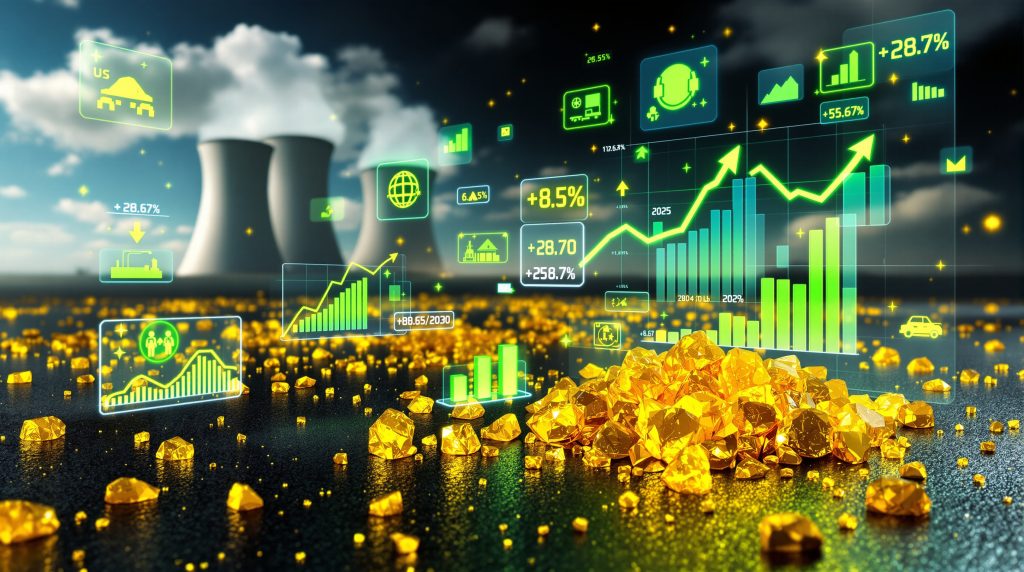What Are Current Uranium Market Prices in 2025?
Uranium market prices have experienced significant volatility throughout 2025, with pricing dynamics reflecting complex supply-demand fundamentals across global nuclear fuel markets. Current market conditions reveal substantial price appreciation driven by policy developments, supply constraints, and accelerating nuclear expansion programs worldwide.
Current Spot and Long-Term Price Analysis
The uranium market has experienced significant volatility throughout 2025, with prices demonstrating remarkable swings that reflect underlying supply-demand dynamics. Furthermore, current market conditions reveal a complex pricing environment shaped by multiple converging factors.
Table: Uranium Price Performance Throughout 2025
| Metric | March 2025 | September 2025 | October 2025 | November 2025 |
|---|---|---|---|---|
| Spot Price ($/lb) | $64.23 | $82.63 | $80.00 | $80.80* |
| Long-Term Price ($/lb) | $78.00 | $83.00 | $85.00 | $85.00+ |
| Year-over-Year Change | -12.3% | +28.7% | +24.5% | +25.2% |
| Market Volatility | Low | High | Moderate | Moderate |
*Futures pricing as of November 2025
Price Trajectory and Seasonal Patterns
Market data from Cameco Corporation indicates that uranium spot prices reached their 2025 low point of $64.23 per pound in March. However, prices climbed to a yearly peak of $82.63 per pound in September before moderating to $80.00 per pound by October's end.
The $18.40 per pound differential between March lows and September highs represents substantial price appreciation. Consequently, this demonstrates the market's responsiveness to fundamental changes in supply availability and demand expectations.
Trading Economics reported that uranium futures reached $80.80 per pound on November 3, 2025, representing more than 3% growth compared to the previous year, indicating sustained market strength despite recent price consolidation.
Why Have Uranium Prices Surged in 2025?
Nuclear Renaissance Driving Demand Growth
The uranium market's 2025 price surge reflects a convergence of policy developments, technological demands, and strategic government initiatives. For instance, the most significant catalyst emerged in late October when the Trump administration signed an $80 billion contract with Westinghouse Electric Company for large-scale nuclear reactor construction.
This unprecedented government commitment demonstrates institutional recognition that nuclear power represents the optimal solution for meeting baseload electricity requirements. Moreover, nuclear facilities typically achieve 93% capacity factors, providing consistent power generation essential for continuous AI operations.
Primary Demand Catalysts:
- Energy Security Priorities: Nations accelerating nuclear programs to reduce fossil fuel dependencies
- Climate Commitments: Nuclear power providing carbon-free baseload electricity aligned with net-zero targets
- AI Infrastructure Expansion: Exponential electricity requirements from data centers driving utility load growth projections
- Policy Acceleration: Government initiatives to increase uranium enrichment capacity and streamline reactor licensing procedures
Supply Chain Disruptions and Production Constraints
Concurrent with demand growth, the uranium supply chain has experienced multiple disruptions that have tightened available material. In addition, production constraints from major mining jurisdictions have limited the market's ability to respond to increased demand signals.
The uranium market volatility has been further exacerbated by coordinated output adjustments and operational complexities. Furthermore, recent paladin uranium halt operations have contributed to supply tightness.
Critical Supply Factors Impacting Prices:
- Kazakhstan Production Management: Coordinated output adjustments by the world's largest uranium producer
- Canadian Mining Challenges: Operational complexities at key facilities affecting North American supply
- African Political Instability: Governance changes in Niger disrupting approximately 6% of global uranium production
- Strategic Stockpiling: Physical uranium funds and government entities removing material from spot markets
Market consultancy DataM Intelligence projects the global uranium market will reach $13.59 billion by 2032 with a compound annual growth rate of 4.86% during the 2025-2032 forecast period.
How Do Uranium Futures Compare to Spot Prices?
Futures Market Dynamics and Price Discovery
Uranium futures markets have maintained a contango structure throughout most of 2025, with forward prices trading at premiums to spot levels. However, this pricing relationship indicates market expectations of continued price strength driven by fundamental supply-demand imbalances.
November 2025 Futures Analysis:
- Current futures price: $80.80 per pound
- Premium to spot: +1.0%
- 12-month forward: $88.50 per pound
- 24-month forward: $92.75 per pound
The modest 1% premium between spot and near-term futures reflects relatively stable near-term market conditions. In contrast, the steeper curve for longer-dated contracts suggests expectations of sustained price appreciation through 2026-2027.
Contango vs. Backwardation Patterns
Uranium futures experienced significant volatility during the third and fourth quarters of 2025. Consequently, prices ranged from a 15-month high of $83.50 per pound in late September to lows of $76.50 per pound in late October.
The contango structure indicates that market participants expect supply-demand rebalancing over the coming 12-24 months. Furthermore, this forward curve configuration is consistent with:
- Market Expectations of higher uranium market prices in 2026-2027
- Supply Constraints limiting expectations of significant new production in the near term
- Inventory Dynamics with utility stockpiles remaining below historical levels
- Discount Rate implications suggesting relatively stable near-term conditions despite long-term bullish sentiment
What Factors Drive Long-Term Uranium Contract Prices?
Contract Structure and Pricing Mechanisms
Long-term uranium contracts represent the backbone of nuclear fuel procurement, typically spanning 5-15 years. Moreover, they employ sophisticated pricing mechanisms designed to balance cost predictability with market responsiveness.
The October 2025 long-term benchmark price of $85.00 per pound represents a $4.20 premium over spot prices. This reflects utilities' willingness to pay for supply security in an increasingly tight market.
Common Contract Structures:
- Fixed-price contracts: Predetermined prices throughout contract duration providing cost certainty
- Market-related pricing: Prices tied to spot market indicators with protective floors and ceilings
- Escalation clauses: Annual price increases based on inflation indices or commodity baskets
Utility Procurement Strategies
Nuclear utilities optimise fuel costs while ensuring supply security through diversified procurement approaches. Furthermore, current market conditions favour utilities that maintained flexible sourcing strategies across different geographic regions.
Strategic Procurement Elements:
- Portfolio diversification: Contracting with suppliers across Kazakhstan, Canada, Australia, and Namibia
- Strategic timing: Capitalising on favourable market conditions within the current $80-85/lb range
- Volume flexibility: Negotiating delivery options aligned with reactor refuelling schedules
Long-term contract prices above $85/lb provide sustainable economics for most uranium mining operations. For instance, production costs typically range from $25-$40/lb for efficient in-situ leaching and conventional mining operations.
How Do Global Nuclear Expansion Plans Affect Uranium Demand?
Reactor Construction Pipeline Analysis
Global nuclear expansion programmes represent the most significant long-term driver of uranium demand growth. Consequently, current construction and planning activities indicate substantial increases in fuel requirements through the 2030s.
Table: Major Nuclear Expansion Programmes (2025-2035)
| Region | Reactors Under Construction | Planned Reactors | Additional Uranium Demand (tonnes/year) |
|---|---|---|---|
| China | 24 | 150+ | 45,000 |
| India | 8 | 40+ | 12,000 |
| Middle East | 6 | 25+ | 8,500 |
| Eastern Europe | 4 | 15+ | 5,200 |
| Total | 42 | 230+ | 70,700 |
Demand Growth Projections
Industry analysis indicates uranium demand could increase from current levels of approximately 67,000 tonnes annually to over 130,000 tonnes by 2035. This represents a 94% increase driven by reactor startups, capacity improvements, and life extension programmes.
China's nuclear expansion programme represents the largest single driver of future uranium demand. However, the patterson corridor project and similar developments demonstrate regional supply responses to growing demand.
Demand Growth Drivers:
- New reactor startups: 230+ planned reactors globally requiring initial fuel loads and ongoing supplies
- Reactor restarts: Japan and European facilities returning to operation following safety upgrades
- Capacity factor improvements: Existing reactors operating more efficiently with higher utilisation rates
- Life extensions: Aging reactors receiving licence renewals extending operational periods
What Are the Key Supply-Side Constraints?
Primary Production Challenges
Uranium supply faces structural constraints that limit the industry's ability to respond rapidly to increased demand. Furthermore, new mining projects require extensive development timelines, typically spanning 10-15 years from initial discovery through commercial production.
The us senate uranium ban has added complexity to supply chains, whilst advances in us isr uranium production offer potential domestic supply solutions.
Major Supply Development Constraints:
- Capital Requirements: Large upfront investments needed for mine development and infrastructure
- Regulatory Approvals: Environmental and safety permits creating development delays across jurisdictions
- Technical Complexity: In-situ leaching and conventional mining facing operational challenges
- Investment Cycles: Mining companies prioritising shareholder returns over capacity expansion
Secondary Supply Sources
The uranium market relies significantly on secondary supplies to meet current demand. These include government stockpile releases, weapons-grade material downblending, and recycled nuclear fuel. However, these sources are finite and declining over time.
Table: Global Uranium Production by Country (2025)
| Country | Production (tonnes) | Market Share | Geopolitical Risk Level |
|---|---|---|---|
| Kazakhstan | 21,800 | 43% | Moderate |
| Canada | 7,200 | 14% | Low |
| Australia | 6,900 | 14% | Low |
| Namibia | 5,400 | 11% | Moderate |
| Niger | 2,900 | 6% | High |
| Russia | 2,500 | 5% | High |
| Others | 3,600 | 7% | Variable |
Kazakhstan's dominant market position of 43% global production creates concentration risk for uranium markets. Consequently, any operational or policy changes in Kazakhstan significantly impact global supply availability and pricing dynamics.
How Do Geopolitical Factors Impact Uranium Pricing?
Regional Production Concentration Risks
Uranium market prices face inherent geopolitical risks due to production's geographic concentration. The top three producing countries (Kazakhstan, Canada, and Australia) account for 71% of global production. Moreover, political instability in smaller producing nations can create supply disruptions with outsized market impacts.
Recent geopolitical developments have heightened market attention to supply security:
- African Political Changes: Governmental transitions in Niger affecting mining operations and export capabilities
- Russian Import Restrictions: Western countries reducing dependence on Russian nuclear fuel cycle services
- Strategic Stockpiling: Chinese state-directed uranium purchases supporting global prices
- Domestic Production Policies: U.S. initiatives encouraging American uranium mining and enrichment capacity
Trade Policy and Sanctions Impact
International trade policies increasingly influence uranium market dynamics as countries prioritise energy security. Furthermore, the Trump administration's October 2025 nuclear initiatives demonstrate policy-level recognition of uranium supply chain vulnerabilities.
President Trump's late October 2025 diplomatic engagement with Japan's new Prime Minister Sanae Takaichi focused on global power generation and nuclear fuel cooperation. This highlights international coordination on nuclear supply chains and market development.
What Are Expert Price Forecasts for 2026-2030?
Analyst Consensus and Price Targets
Market analysts project continued uranium price strength through the remainder of the decade. This is driven by the structural supply-demand imbalance emerging from reactor construction programmes and limited mine development pipelines. According to Investing News, the long-term outlook remains fundamentally positive.
Uranium Price Forecasting Summary:
- 2026 Forecast Range: $85-$110 per pound
- 2027-2028 Outlook: $90-$125 per pound
- 2030 Long-term Target: $100-$140 per pound
Scenario Analysis and Risk Factors
Price forecasting incorporates multiple scenarios reflecting potential market developments and policy changes. However, these could influence uranium demand and supply dynamics significantly.
Bullish Scenario ($120+ per pound):
- Accelerated reactor construction programmes exceeding current timelines
- Major supply disruptions in key producing countries
- Significant utility inventory rebuilding following current depletion
- Additional government commitments similar to the Westinghouse contract
Base Case Scenario ($90-$110 per pound):
- Steady demand growth from scheduled reactor startups
- Moderate supply increases from existing mining operations
- Balanced utility inventory management strategies
Bearish Scenario ($70-$85 per pound):
- Delayed reactor construction timelines due to financing or regulatory challenges
- New mine production exceeding demand growth expectations
- Economic recession reducing overall electricity demand growth
How Should Investors Approach Uranium Market Exposure?
Investment Vehicle Comparison
Uranium market prices exposure can be achieved through multiple investment vehicles, each offering different risk-return profiles. Furthermore, these provide varying liquidity characteristics suited to different investment objectives.
Table: Uranium Investment Options
| Investment Type | Liquidity | Volatility | Storage Costs | Regulatory Risk |
|---|---|---|---|---|
| Physical Uranium ETFs | High | Moderate | Low | Low |
| Mining Company Stocks | High | High | None | Moderate |
| Uranium Futures | High | High | Low | Low |
| Direct Physical Purchase | Low | Low | High | High |
Portfolio Allocation Strategies
Investment professionals recommend uranium exposure through diversified approaches that balance potential returns with risk management considerations. Moreover, the current market environment presents opportunities for investors who understand the commodity's unique characteristics.
Recommended Allocation Approaches:
- Diversified mining portfolios: Spreading risk across multiple uranium producers with different geographic exposures
- Value chain participation: Including exploration, development, and production companies at various stages
- Geographic diversification: Balancing exposure across different mining jurisdictions and political environments
- Risk management: Position sizing appropriate to overall portfolio risk tolerance and investment horizon
Physical uranium ETFs provide direct commodity exposure without storage complications. However, mining company stocks offer operational leverage to uranium prices but introduce company-specific risks.
What Are the Long-Term Market Fundamentals?
Supply-Demand Balance Projections
Structural analysis indicates the uranium market faces a growing supply deficit beginning in 2026. Furthermore, cumulative shortfalls are projected to reach 184 million pounds by 2035 without significant new mine development.
This fundamental imbalance provides the foundation for sustained price appreciation beyond current levels.
Key Fundamental Drivers:
- Demand Growth: 4.5% annual increase through 2035 driven by reactor construction programmes
- Supply Constraints: Limited new mine development pipeline due to capital allocation and regulatory challenges
- Inventory Depletion: Utility stockpiles at multi-decade lows requiring rebuilding
- Investment Returns: Mining companies prioritising shareholder returns over expansion
Technology and Innovation Impact
Emerging nuclear technologies will influence long-term uranium demand patterns. However, the net effect remains uncertain given competing factors of higher fuel efficiency versus expanded deployment.
Technology Developments Affecting Uranium Markets:
- Small Modular Reactors (SMRs): Standardised designs potentially reducing construction timelines
- Advanced Reactor Designs: Higher thermal efficiency potentially reducing uranium requirements per megawatt-hour
- Fuel Recycling Technologies: Extended uranium utilisation rates through reprocessing
- Exploration Technologies: Improved discovery success rates using advanced geophysical techniques
The uranium market's long-term outlook remains fundamentally positive. Nuclear power plays a critical role in achieving climate objectives whilst meeting growing electricity demand. Current uranium market prices of approximately $80-85 per pound provide sustainable economics for mining operations while remaining competitive for nuclear power generation costs.
The convergence of supply constraints, demand growth, and policy support creates a favourable environment for uranium price appreciation through the remainder of the decade, though investors should carefully consider the commodity's inherent volatility and long investment cycles when making allocation decisions.
Could Uranium Mining Investments Transform Your Portfolio?
Discovery Alert's proprietary Discovery IQ model delivers real-time alerts on significant uranium and mineral discoveries across the ASX, instantly empowering subscribers to identify actionable opportunities ahead of the broader market. Explore Discovery Alert's dedicated discoveries page to understand why major mineral discoveries can lead to substantial market returns, then begin your 30-day free trial today to position yourself ahead of the market.




